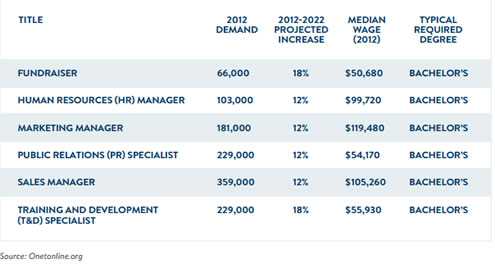New report reveals that need for communications skills and degrees are expanding throughout all industries
 [1]STEM skills and degrees are getting a lot of press lately, and especially the newcomer ‘entrepreneurship,’ but according to interesting national data from both the government and job sector, its communication skills that are not only most in-demand now, but hold continuing promise for the near future, thanks to data, social and mobile technologies.
[1]STEM skills and degrees are getting a lot of press lately, and especially the newcomer ‘entrepreneurship,’ but according to interesting national data from both the government and job sector, its communication skills that are not only most in-demand now, but hold continuing promise for the near future, thanks to data, social and mobile technologies.
The data comes from the College for America at Southern New Hampshire University’s Occupational Trend Report for August [2], and highlights six growing careers need advanced communication skills from graduating students now.
For example, in a study of 2010-11 college graduated, Georgetown University found [3] that, even as the U.S. was just beginning to emerge from the Great Recession, communications degree holders with some work experience had an unemployment rate of just 6 percent—24 percent lower than the national average among college grads at 7.9 percent.
Also, the National Center for Education Statistics and the Institute of Education Sciences reported that [4], between 1999 and 2012, the number of college students in communications programs increased from over 55,000 to over 81,000. And as of August 2014, communications ranked eighth [5] among the top 10 studied bachelor’s degrees, as identified by The Princeton Review.
“Between mobile technology and social media, people today are always connected,” explains Melissa Goldberg, senior workforce strategist at College for America and primary author of the report. “This connectedness has altered how we consume information and interact with other people, brands, and organizations. As a result, employees now need to have strong communication skills—whether or not they are in traditional communications careers.”
(Next page: 6 of today’s fastest growing professions and how communication skills fit in)
According to the report (using data from the labor market, current job listings, and input from subject matter experts), more and more occupations in today’s job market need employees to be people-centric, having the types of skills to: identify and target the correct audience, determine the best communication channels and mediums, and craft a message that “cuts through the noise.”
“Moreover, social media has increased audience expectations for two-way communication and interactivity—so people-oriented professionals must be able to quickly engage with audiences in near-real time,” notes Goldberg. “They also need the skills to take advantage of the insights that are available through internet-based social interactions.”
Some of the fastest-growing professions, which are communication skills-critical, are:
“While these positions differ greatly in goals and responsibilities, they share a number of communications-relevant skills, or detailed work activities (DWAs)—an occupational classification system of the US federal government’s O*NET program,” says the report.
DWAs describe business work tasks that can be found across multiple occupations and remain constant over time, and the report explains that they’re logical units of analysis for hiring and promoting employees, as well as for curriculum and training program development, because they “transcend frequently changing industry-staffing patterns and company-specific job descriptions.”
The communications-oriented DWAs that largely cut across the six positions noted include:
“The communications responsibilities in these roles are not new,” explains Goldberg, “but they have been amplified, expanded, and made more complex by the variety of communication channels, speed at which information is exchanged, and need for engaging messaging. As a result, there’s a far greater degree of ‘cross-pollination’ of communications skills among these occupations.”
Goldberg hopes that the findings from the report can inform recruitment, workforce development programs, and succession planning policies, as well as help policymakers considering investments in workforce programs; and educators charged with curriculum development.
Colleges and universities across the country should also consider investing more in communications degrees and skills pathways for students eager to get a leg-up in the job market.
For more information on the report, it’s bibliography, as well as in-depth case studies of professionals in each of the six communications-centric careers, read the full report here [2].

